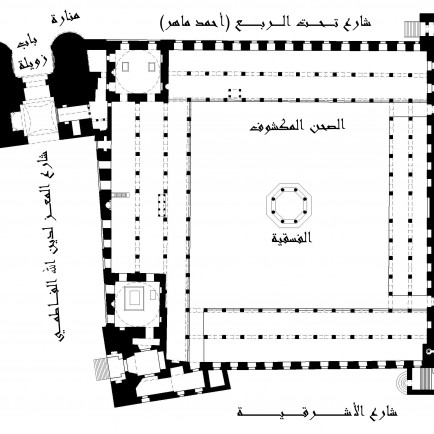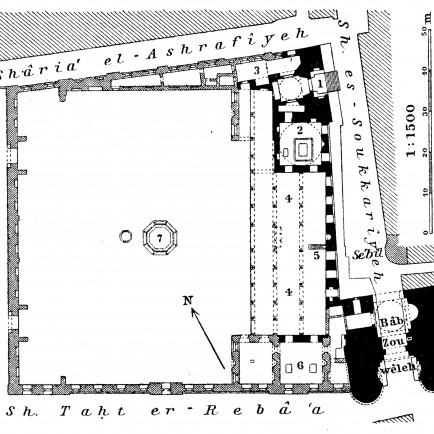The Mosque of Sultan al-Mu'ayyad
History
The Sultan al-Mu'ayyad complex is located near the Bab Zuwayla gate and originally included a madrasa-khanqah, a Friday mosque, and two mausoleums. It was built between 1415 and 1422. However, unlike the madrasa-khanqah of Barquq, in which Sufis and students lived under the same roof, this madrasa, whose program included the study of the official religion according to the four rites , was dedicated only to the Sufis.
Urban and Architectural
The mosque of Sultan al-Mu'ayyad was the last major hypostyle mosque built in Cairo.Initially, it had four fronts and entrances.Over time, the mosque fell into ruin, and today, only the east façade and the prayer hall are the originals of the mosque.Much of what can be seen today has been restored in the last 200 years and is not necessarily like the mosque originally.
In order to build the mosque, a portion of the Fatimid wall which used to surround Cairo had to be demolished. however, an old section of the wall was recently discovered within the mosque's structure and can be seen today by visitors.The two towers of the door near Bab Zuweila. placed in the original.Wall, were saved from demolition and serve as the base of the two remaining minarets of the mosque. an unusual and unique.typical of the mosque complex.
Description
Originally the mosque had three minarets, the two we see above the towers of Bab Zuwayla are twins. The third of different appearance was destroyed during the 19th century. The two remaining minarets are particularly slender and elegant. The carved rafters that adorn the octagonal second stories are an excellent example of carved masonry from this period. Shortly after their completion, one of them began to lean dangerously towards one of the neighboring buildings. The minaret was demolished and rebuilt. The demolition work lasted a day and cost the life of a worker killed by falling rocks. Bab Zuwayla was closed for a month during its reconstruction.
References
https://www.archnet.org/sites/2299
https://en.wikipedia.org/wiki/Mosque_of_Sultan_al-Muayyad
Details
Location
Al Shrakia, El-Darb El-Ahmar, Cairo Governorate, Égypte
Worshippers
3000
Owners
sultan Al-Mu'ayyad Sayf ad-Din Shaykh
Year of Build
1421
Area
6000
Drawings
Map
History
The Sultan al-Mu'ayyad complex is located near the Bab Zuwayla gate and originally included a madrasa-khanqah, a Friday mosque, and two mausoleums. It was built between 1415 and 1422. However, unlike the madrasa-khanqah of Barquq, in which Sufis and students lived under the same roof, this madrasa, whose program included the study of the official religion according to the four rites , was dedicated only to the Sufis.
Urban and Architectural
The mosque of Sultan al-Mu'ayyad was the last major hypostyle mosque built in Cairo.Initially, it had four fronts and entrances.Over time, the mosque fell into ruin, and today, only the east façade and the prayer hall are the originals of the mosque.Much of what can be seen today has been restored in the last 200 years and is not necessarily like the mosque originally.
In order to build the mosque, a portion of the Fatimid wall which used to surround Cairo had to be demolished. however, an old section of the wall was recently discovered within the mosque's structure and can be seen today by visitors.The two towers of the door near Bab Zuweila. placed in the original.Wall, were saved from demolition and serve as the base of the two remaining minarets of the mosque. an unusual and unique.typical of the mosque complex.
Description
Originally the mosque had three minarets, the two we see above the towers of Bab Zuwayla are twins. The third of different appearance was destroyed during the 19th century. The two remaining minarets are particularly slender and elegant. The carved rafters that adorn the octagonal second stories are an excellent example of carved masonry from this period. Shortly after their completion, one of them began to lean dangerously towards one of the neighboring buildings. The minaret was demolished and rebuilt. The demolition work lasted a day and cost the life of a worker killed by falling rocks. Bab Zuwayla was closed for a month during its reconstruction.




